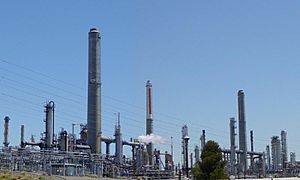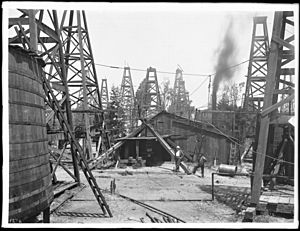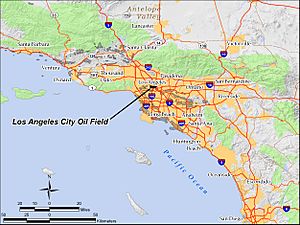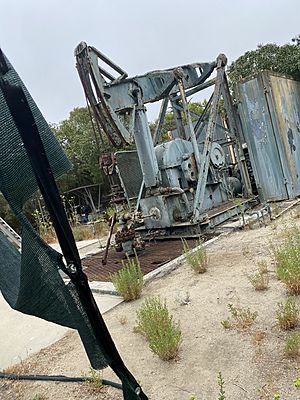California oil and gas industry facts for kids
The California oil and gas industry has been very important for over 100 years. In the 1800s, oil was used for things like kerosene lamps and lubricants for machines. But in the 1900s, it became a huge industry in California. This happened because new oil fields were found near Los Angeles and in the San Joaquin Valley. Also, more and more people started using cars and trucks, which needed a lot of gasoline.
In 1900, California produced about 4 million barrels of oil. This was almost 5% of all the oil made in the U.S. After many big discoveries, the state produced 100 million barrels in 1914. That was 38% of the country's oil! By 2012, California was still producing a lot of oil, about 197 million barrels. Most of California's oil drilling happens in Kern County, the San Joaquin Valley, and the Los Angeles Basin.
California also has some oil and gas wells in the ocean. However, there are strict rules now. No new offshore oil projects or platforms are allowed in California waters. These rules were put in place after a big oil spill in Santa Barbara in 1969. California produces some natural gas, but it buys most of its gas from other states through pipelines.
Contents
How Oil Was First Discovered in California
In the 1850s and 1860s, people knew there was oil in California because it would seep out of the ground. Experts thought this oil could be very valuable. Many early attempts to find oil failed, even though people spent a lot of money. The oil they found was often not very good quality.
After 1848, more and more places with oil seeps were found. These were in Northern California (like Humboldt and Santa Clara Counties) and Southern California (like Ventura and Los Angeles Counties). People became very interested in oil after a big discovery in Pennsylvania in 1859.
In 1864, a smart chemistry professor named Benjamin Silliman, Jr. looked at the oil seeps in Ventura County. He said there was a lot of oil that could be used for business. This led people like Leland Stanford to dig tunnels into mountains to collect oil. Other companies drilled wells. One well in the Ojai region became California's first "gusher," meaning oil shot out of the ground!
Early oil discoveries were sometimes made by hand-digging wells or tunneling into mountains. The oil would flow out of the tunnels. Some of this oil was so thick that pipelines had to be heated in winter to make it flow. Getting the oil to a place where it could be used or cleaned was always a challenge. In 1866, the first oil refinery in California was built near McKittrick Tar Pits in Kern County. It turned crude oil into kerosene and asphalt.
Much of California's early oil was found as asphalt, also called bitumen. This is a thick, black, sticky form of petroleum. It was found naturally and could also be made from crude oil. In the 1870s, some California cities started using asphalt to pave their streets. This helped with dust and mud. Today, asphalt is mostly used to build roads, where it acts like a glue to hold gravel together.
California's Oil Production Grows
California's oil story really began in the late 1800s. By 2012, California was the third-biggest oil-producing state in the U.S., after Texas and North Dakota. In the 1900s, the oil industry became the state's most profitable business.
A company called Standard Oil controlled most of the oil distribution in California. In 1911, the Supreme Court broke up Standard Oil. Its California operations became Standard Oil of California, which is now part of Chevron Corporation.
The Los Angeles City Oil Field was discovered in 1890. It became famous when Edward L. Doheny drilled a successful well there in 1892. This field produced more than half of California's oil in 1895. Doheny became one of the richest people in California. In 1901, there were 200 different oil companies working in this field! By 2011, only one small well was still producing oil there.
In 1903, California became the top oil-producing state in the U.S. It traded the number one spot with Oklahoma until 1930. Oil production grew from 34 million barrels in 1904 to 78 million barrels by 1910.
By 1920, California's oil production reached 77 million barrels. Between 1920 and 1930, many new oil fields were found across Southern California. These included Huntington Beach (1920), Long Beach (1921), and Santa Fe Springs (1921). Southern California became a very busy place for oil production.
In 1929, there was too much oil available in Southern California and across the U.S. This problem got worse during the Great Depression. Oil prices dropped very low, sometimes selling for only 25 cents a barrel. Later, in the mid-1930s, a group called the Railroad Commission of Texas helped set the national price of oil.
Oil in the San Joaquin Valley
For a long time, farming was the main activity in the San Joaquin Valley. But in 1899, "black gold" (oil) was found in a shallow well near the Kern River. This discovery started an oil boom! Soon, many wooden derricks appeared near Bakersfield. The Kern River field quickly produced 7 out of every 10 barrels of oil from California. By 1903, it helped make California the top oil-producing state.
After the Kern River discovery, oil explorers spread out across the San Joaquin Valley. Many new oil fields were found. Big oil gushers at Coalinga, McKittrick, and Midway-Sunset fields kept the valley in the news.
The San Joaquin Valley is home to 21 "giant" oil fields. Each of these has produced over 100 million barrels of oil. Four of them are "super giants," producing over 1 billion barrels! These include Midway-Sunset (the largest oil field in the lower 48 U.S. states) and Elk Hills.
Refining and Distributing Oil

In the early 1900s, five main companies controlled most of the oil refining and distribution in California. The biggest was California Standard (Chevron Corporation). Another important company was Union Oil Company, started in 1890. Shell Company of California was also a major player.
California Shale Oil
The Monterey shale is a type of rock found in Southern California. Some people thought it held a huge amount of oil. For many years, oil has been found in parts of this rock where it's naturally cracked. Oil companies are trying to find ways to get oil from other parts of the shale by creating new cracks. This process is called fracking. It involves pumping water, sand, and chemicals into the rock under high pressure.
However, it has been hard to get a lot of oil from the Monterey shale using fracking. In 2013, the U.S. Energy Information Administration thought there were over 15 billion barrels of oil there. But later studies showed that only about 21 million barrels of "tight oil" could be easily reached. This is because the rock layers in California are very complex and folded, making drilling difficult.
Important Moments in California Oil History
- 1866 - The first oil refinery in Kern County is built near McKittrick.
- 1875 - The first commercial oil field in California is found at Pico Canyon in Los Angeles County.
- 1885 - Gas wells are drilled in Stockton, California, for fuel and lighting.
- 1886 - Gasoline-powered cars are introduced in Europe.
- 1890 - The Union Oil Company of California is founded.
- 1892 - Edward L. Doheny discovers oil in downtown Los Angeles.
- 1899 - A hand-dug oil well discovers the Kern River field, starting an oil boom.
- 1903 - Kern River and Midway-Sunset oil fields help make California the top oil-producing state.
- 1908 - The Ford Model T car makes gasoline-powered automobiles popular for everyone.
- 1909 - The Midway Gusher blows out, drawing attention to the Midway-Sunset field.
- 1910 - The Lakeview Gusher blows in near Taft, becoming America's biggest oil gusher.
- 1911 - Standard Oil is split into many companies, including Standard Oil of California.
- 1914 - The Panama Canal opens, allowing California oil to be shipped to other places.
- 1915 - The price of gasoline drops to a low of 11 cents a gallon.
- 1929 - Equipment to prevent oil well blowouts becomes required in California.
- 1936 - The first seismic exploration in California helps find the Ten Section oil field.
- 1961 - Steam recovery projects start in Kern County to get more oil out of the ground.
- 1969 - A big oil leak happens near Union Oil's platform in the Santa Barbara Channel. This leads to new environmental laws.
- 1985 - Kern County reaches its highest oil production ever, at 256 million barrels a year. California also reaches its highest production ever, at 424 million barrels a year.
- 2005 - Chevron buys Unocal, another big oil company.
- 2010 - Hydraulic fracturing (fracking) of shale oil deposits leads to new supplies of natural gas and more oil production.
California's Natural Gas Production
When natural gas was first found, it was often just let out into the air or burned off. Only a small amount was used for lighting or heating. Before electric lights, cities used gas street lamps.
The natural gas industry changed a lot after huge gas fields were found in the American Southwest starting in 1918. This new natural gas was cleaner and cheaper than gas made from coal. In 1929, PG&E built a 300-mile pipeline to bring natural gas to the San Francisco Bay area. This made San Francisco the first major city to switch from coal gas to natural gas.
During World War II, more people and industries in California needed natural gas. This used up a lot of the state's gas reserves. So, in 1947, PG&E made a deal to buy natural gas from Texas and New Mexico through a new 1,000-mile pipeline.
In 2012, California was the 13th largest state for natural gas production. Today, natural gas is the second most used energy source in California. About 45% of the natural gas used is burned in power plants to make electricity. These plants are often very efficient. About 9% of the gas helps get more oil and gas out of the ground. The rest is used for homes (heating, cooking), businesses, and industries. Some is even used to fuel buses and trucks.
California imports about 85% of its natural gas using six large pipelines. Most of this gas comes from the American Southwest, the Rocky Mountain states, and Canada. The remaining 15% of California's natural gas is produced within the state, both on land and offshore.
Natural gas power plants are very important for electricity in California. They can quickly start up to provide power when other sources, like solar or wind, are not producing enough. Natural gas plants also release about half the CO2 that coal plants do. California gets about 14% of its electricity from water power, but this depends on how much rain the state gets each year.
Natural gas prices went up in 2007 but have gone down since then. This is because more gas has become available across the U.S. The biggest reason for this increase is new drilling methods like horizontal drilling and hydraulic fracturing.
Six major pipelines bring natural gas into California. Inside California, over 100,000 miles of pipelines deliver gas to homes and businesses. There are also 10 natural gas storage facilities in California. These are often old oil or gas fields underground.
Oil and Gas in Books and Movies
The early California oil industry has been the setting for several interesting books and films:
- Oil! (1927): A novel by Upton Sinclair about the California oil industry. It is partly based on the life of Edward Doheny.
- There Will Be Blood (2007): A movie loosely based on the novel Oil!, and also on research about Edward Doheny.
- Boom Town (1940): A film about oil drilling, including scenes in California oil towns like Taft and Bakersfield.
- Five Easy Pieces (1970): This movie, starring Jack Nicholson, has many scenes filmed in the Southern California oil fields.
|




